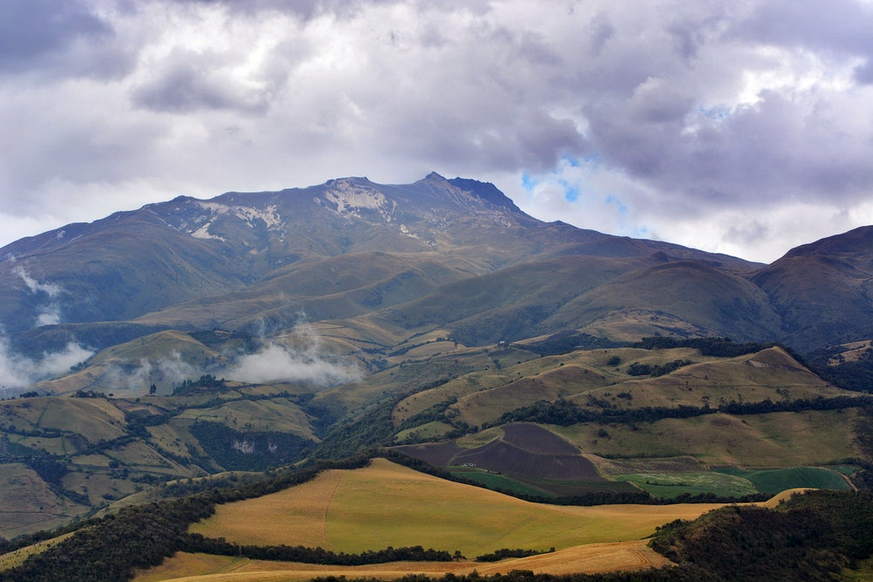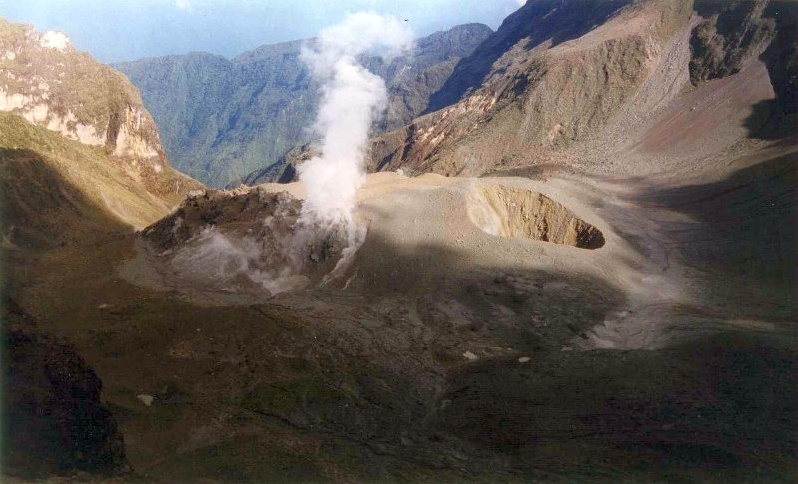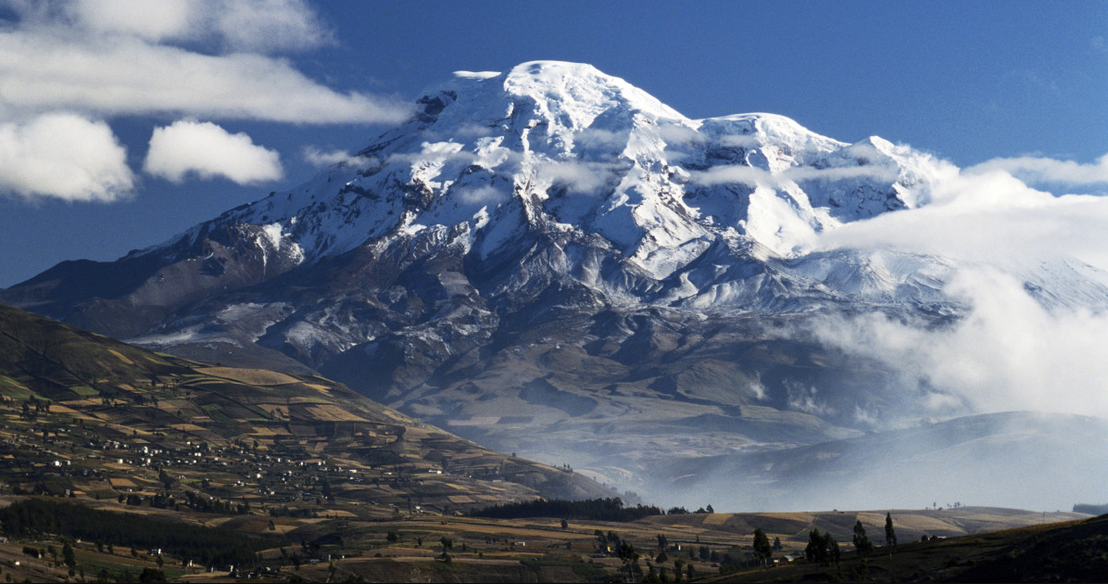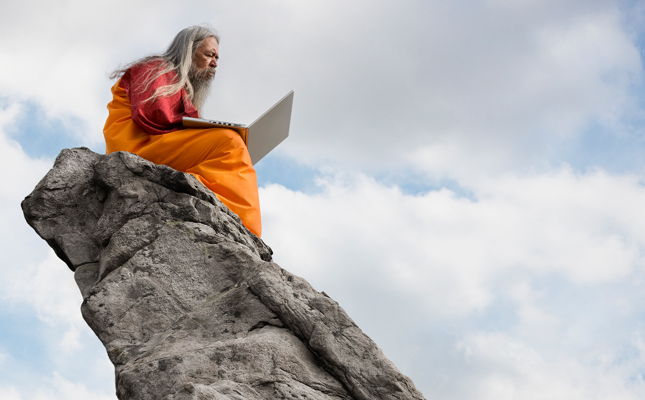Editor’s note: The following account by explorer James Orton, who led an expedition to South America in 1867, is extracted from With the World’s Great Travellers, Vol. II (published 1901). All spelling in the original.
Coming up from Peru through the cinchona forests of Loja, and over the barren hills of Assuay, the traveller reaches Riobamba seated on the threshold of magnificence,—like Damascus, an oasis in a sandy plain, but, unlike the Queen of the East, surrounded with a splendid retinue of snowy peaks that look like icebergs floating in a sea of clouds.
On our left is the most sublime spectacle in the New World. It is a majestic pile of snow, its clear outline on the deep blue sky describing the profile of a lion in repose. At noon the vertical sun, and the profusion of light reflected from the glittering surface, will not allow a shadow to be cast on any part, so that you can easily fancy the figure is cut out of a mountain of spotless marble. This is Chimborazo,—yet not the whole of it,—you see but a third of the great giant. His feet are as eternally green as his head is everlastingly white; but they are far away beneath the banana and cocoanut palms of the Pacific coast.
Rousseau was disappointed when he first saw the sea; and the first glimpse of Niagara often fails to meet one’s expectations. But Chimborazo is sure of a worshipper the moment its overwhelming grandeur breaks upon the traveller. You feel that you are in the presence-chamber of the monarch of the Andes. There is sublimity in his kingly look of which the ocean might be proud.

Well do we remember our disappointment as we stood before that wonder of the world,—St. Peter’s. We mounted the pyramid of steps and looked up, but were not overcome by the magnificence. We read in our guide-book that the edifice covers eight acres, and to the tip-top of the cross is almost five hundred feet; that it took three hundred and fifty years and twelve successive artists to finish it and an expenditure of fifty million dollars, and now costs thirty thousand dollars per annum to keep it in repair, still we do not appreciate its greatness. We pushed aside the curtain and walked in,—walked a day’s journey across the transept and up and down the everlasting nave, and yet continued heterodox. We tried hard to believe it was very vast and sublime, and we knew we ought to feel its grandeur, but somehow we did not. Then we sat down by the Holy of Holies, and there we were startled into a better judgment by the astounding fact that the Cathedral of St. Paul—the largest edifice in Great Britain—could stand upright, spire, dome, body, and all, inside of St. Peter’s! that the letters of the inscription which run round the base of the dome, though apparently but an inch, are in reality six feet high! Then for the first time the scales fell from our eyes, the giant building began to grow; higher and higher still it rose, longer and deeper it expanded, yet in perfect proportions; the colossal structure, now a living temple, put on its beautiful garments and the robe of majesty. And that dome! the longer we looked at it the vaster it grew, till finally it seemed to be a temple not made with hands; the spacious canopy became the firmament; the mosaic figures of cherubim and seraphim were endowed with life; and as we fixed our eyes on the zenith where the Almighty is represented in glory, we thought we had the vision of Stephen. Long we gazed upward into this heaven of man’s creation, and gazed again till we were lost in wonder.
But the traveller needs no such steps to lift him up to the grand conception of the divine Architect as he beholds the great white dome of Chimborazo. It looks lofty from the very first. Now and then an expanse of thin, sky-like vapor would cut the mountain in twain, and the dome, islanded in the deep blue of the upper regions, seemed to belong more to heaven than to earth. We knew that Chimborazo was more than twice the altitude of Etna. We could almost see the great Humboldt struggling up the mountain’s side till he looked like a black speck moving over the mighty white, but giving up in despair four thousand feet below the summit. We see the intrepid Bolivar mounting still higher; but the hero of Spanish-American independence returns a defeated man. Last of all comes the philosophic Boussingault, and attains the prodigious elevation of nineteen thousand six hundred feet,—the highest point reached by man without the aid of a balloon; but the dome remains unsullied by his foot. Yet none of these facts increase our admiration. The mountain has a tongue which speaks louder than all mathematical calculations.

There must be something singularly sublime about Chimborazo, for the spectator at Riobamba is already nine thousand feet high, and the mountain is not so elevated above him as Mont Blanc above the vale of Chamouni, when, in reality, that culminating point of Europe would not reach up even to the snow-limit of Chimborazo by two thousand feet. It is only while sailing on the Pacific that one sees Chimborazo in its complete proportions. Its very magnificence diminishes the impression of awe and wonder, for the Andes on which it rests are heaved to such a vast altitude above the sea, that the relative elevation of its summit becomes reduced by comparison with the surrounding mountains. Its altitude is twenty-one thousand four hundred and twenty feet, or forty-five times the height of Strasburg cathedral; or, to state it otherwise, the fall of one pound from the top of Chimborazo would raise the temperature of water thirty degrees. One-fourth of this is perpetually covered with snow, so that its ancient name Chimpurazu—the mountain of snow—is very appropriate. It is a stirring thought that this mountain, now mantled with snow, once gleamed with volcanic fires. There is a hot spring on the north side, and an immense amount of débris covers the slope below the snow-limit, consisting chiefly of fine-grained, iron-stained trachyte and coarse porphyroid gray trachyte; very rarely a dark vitreous trachyte. Chimborazo is very likely not a solid mountain; trachytic volcanoes are supposed to be full of cavities. Bouger found it made the plumb line deviate 7″ or 8″.
The valleys which furrow the flank of Chimborazo are in keeping with its colossal size. Narrower, but deeper, than those of the Alps, the mind swoons and sinks in the effort to comprehend their grim majesty. The mountain appears to have been broken to pieces like so much thin crust, and the strata thrown on their vertical edges, revealing deep, dark chasms, that seem to lead to the confines of the lower world. The deepest valley in Europe, that of the Ordesa in the Pyrenees, is three thousand two hundred feet deep; but here are rents in the side of Chimborazo in which Vesuvius could be put away out of sight. As you look down into the fathomless fissure, you see a white fleck rising out of the gulf, and expanding as it mounts, till the wings of the condor, fifteen feet in spread, glitter in the sun as the proud bird fearlessly wheels over the dizzy chasm, and then, ascending above your head, sails over the dome of Chimborazo. Could the condor speak, what a glowing description he could give of the landscape beneath him when his horizon is a thousand miles in diameter! If
“Twelve fair counties saw the blaze from Malvern’s lonely height,”
what must be the panorama from a height fifteen times higher!
Chimborazo was long supposed to be the tallest mountain on the globe, but its supremacy has been supplanted by Mount Everest in Asia, and Aconcagua in Chile. In mountain gloom and glory, however, it still stands unrivalled. The Alps have the avalanche, “the thunderbolt of snow,” and the glaciers, those icy Niagaras so beautiful and grand. Here they are wanting. The monarch of the Andes sits motionless in calm serenity and unbroken silence. The silence is absolute and actually oppressive. The road from Guayaquil to Quito crosses Chimborazo at the elevation of fourteen thousand feet. Save the rush of the trade wind in the afternoon, as it sweeps over the Andes, not a sound is audible; not the hum of an insect, nor the chirp of a bird, nor the roar of the puma, nor the music of running waters. Mid-ocean is never so silent. You can almost hear the globe turning on its axis. There was a time when the monarch deigned to speak, and spoke with a voice of thunder, for the lava on its sides is an evidence of volcanic activity. But ever since the morning stars sang together over man’s creation Chimbo has sat in sullen silence, satisfied to look “from his throne of clouds o’er half the world.” There is something very suggestive in this silence of Chimborazo. It was once full of noise and fury; it is now a completed mountain, and thunders no more. How silent was Jesus, a completed character! The reason that we are so noisy is that we are so full of wants; we are unfinished characters. Had we perfect fulness of all things, the beatitude of being without a want, we should lapse into the eternal silence of God.
Chimborazo is a leader of a long train of ambitious crags and peaks; but as he who comes after the king must not expect to be noticed, we will only take a glimpse of these lesser lights as we pass up the Western Cordillera, and then down the Eastern.

The first after leaving the monarch is Caraguairazo. The Indians call it “the wife of Chimborazo.” They are separated only by a very narrow valley. One hundred and seventy years ago the top of this mountain fell in, and torrents of mud flowed out containing multitudes of fishes. It is now over seventeen thousand feet high, and is one of the most Alpine of the Quitonian volcanoes, having sharp pinnacles instead of the smooth trachytic domes—usually double domes—so characteristic of the Andean summits. And now we pass in rapid succession numerous picturesque mountains, some of them extinct volcanoes, as Iliniza, presenting two pyramidal peaks, the highest seventeen thousand feet above the sea, and Corazon, so named from its heart-shaped summit, till we reach Pichincha, whose smoking crater is only five miles distant in a straight line from the city of Quito, or eleven by the travelled route.


The crown of this mountain presents three groups of rocky peaks. The most westerly one is called Rucu-Pichincha, and alone manifests activity. To the northeast of Rucu is Guagua-Pichincha, a ruined flue of the same fiery furnace; and between the two is Cundur-Guachana. Pichincha is the only volcano in Ecuador which has not a true cone crater. Some violent eruption beyond the reach of history or tradition has formed an enormous funnel-shaped basin two thousand five hundred feet deep, fifteen hundred in diameter at the bottom, and expanding upward to a width of three-fourths of a mile. It is the deepest crater on the globe. That of Kilauea is six hundred feet; Orizaba, five hundred; Etna, three hundred; Hecla, one hundred. Vesuvius is a portable furnace in comparison. The abyss is girt with a ragged wall of dark trachyte, which rises on the inside at various angles between forty-five degrees and perpendicularity. As we know of but one American besides the members of our expedition (Mr. Farrand, a photographer) who has succeeded in entering the crater of this interesting volcano, we will give a brief sketch of our visit.

Leaving Quito in the afternoon by the old arched gate-way at the foot of Panecillo, and crossing a spur of the mountain, we stopped for the night at the Jesuit hacienda, situated in the beautiful valley of Lloa, but nearly ruined by the earthquake of 1859. On the damp walls of this monastery, perched ten thousand two hundred and sixty-eight feet above the ocean, we found several old paintings, among them a copy of the Visitation by Rubens. The sunset views in this heart of the Andes were surpassingly beautiful. Mounting our horses at break of day, and taking an Indian guide, we ascended rapidly by a narrow and difficult path through the forest that belts the volcano up to the height of twelve thousand feet, emerging gradually into a thicket of stunted bushes, and then entered the dreary paramo. Splendid was the view of the Eastern Cordillera. At least six dazzling white volcanoes were in sight just across the valley of Quito, among them table-topped Cayambi, majestic Antisana, and princely Cotopaxi, whose tapering summit is a mile above the clouds. Toiling upward we reached the base of the cone where vegetation ceased entirely; and tying our horses to some huge rocks that had fallen from the mural cliff above, we started off on hands and feet for the crater. The cone is deeply covered with sand and cinders for about two hundred feet, and the sides are inclined at an angle of about thirty-five degrees. At ten o’clock we reached the brim of the crater, and the great gulf burst suddenly into view.

We can never forget the impression made upon us by the sight. We speak of many things here below as awful, but that word has its full meaning when carried to the top of Pichincha. There you see a frightful opening in the earth’s crust nearly a mile in width and half a mile deep, and from the dark abyss comes rolling up a cloud of sulphurous vapors. Monte Somma in the time of Strabo was a miniature; but this crater is on the top of a mountain four times the height of the Italian volcano. Imagination finds it difficult to conceive a spectacle of more fearful grandeur or such solemn magnificence. It well accords with Milton’s picture of the bottomless pit. The united effect of the silence and solitude of the place, the great depth of the cavity, the dark precipitous sides, and the column of smoke standing over an unseen crevice, was to us more impressive than thundering Cotopaxi or fiery Vesuvius. Humboldt, after standing on this same brink, exclaimed, “I have never beheld a grander or more remarkable picture than that presented by this volcano;” and La Condamine compared it to “the Chaos of the poets.”

Below us are the smouldering fires which may any moment spring forth into a conflagration; around us are black, ragged cliffs,—fit boundary for this gate-way to the infernal regions. They look as if they had just been dragged up from the central furnace of the earth. Life seems to have fled in terror from the vicinity; even lichens, the children of the bare rocks, refuse to clothe the scathed and beetling crags. For some moments made mute by the dreadful sight, we stood like statues on the rim of the mighty caldron, with our eyes riveted on the abyss below, lost in contemplating that which cannot be described. The panorama from this lofty summit is more pleasing, but equally sublime. Towards the rising sun is the long range of the Eastern Cordillera, hiding from our view the great valley of the Amazon. To right and left are the peaks of another procession of august mountains from Cotocachi to Chimborazo. We are surrounded by the great patriarchs of the Andes, and their speaker, Cotopaxi, ever and anon sends his muttering voice over the land.
The view westward is like looking down from a balloon. Those parallel ridges of the mountain chain, dropping one behind the other, are the gigantic staircase by which the ice-crowned Chimborazo steps down to the sea. A white sea of clouds covers the peaceful Pacific and the lower parts of the coast. But the vapory ocean, curling into the ravines, beautifully represents little coves and bays, leaving islands and promontories like a true ocean on a broken shore. We seem raised above the earth, which lies like an opened map below us; we can look down on the upper surface of the clouds, and, were it night, down too upon the lightnings….
The first to reach the brink of the crater were the French Academicians in 1742. Sixty years after Humboldt stood on the summit. But it was not until 1844 that any one dared to enter the crater. This was accomplished by Garcia Moreno, now President of Ecuador, and Sebastian Wisse, a French engineer. Humboldt pronounced the bottom of the crater “inaccessible from its great depth and precipitous descent.” We found it accessible, but exceedingly perilous. The moment we prepared to descend our guide ran away. We went on without him, but when half-way down were stopped by a precipice.
On the 22d of October, 1867, we returned to Pichincha with another guide and entered the crater by a different route. Manuel, our Indian, led us to the south side, and over the brink we went. We were not long in realizing the danger of the undertaking. Here the snow concealed an ugly fissure or covered a treacherous rock (for nearly all the rocks are crumbling), there we must cross a mass of loose sand moving like a glacier down the almost vertical side of the crater; and on every hand rocks were giving way, and, gathering momentum at each revolution, went thundering down, leaping over precipices and jostling other rocks, which joined in the race, till they all struck the bottom with a deep rumbling sound, shivered like so many bomb-shells into a thousand pieces, and telling us what would be our fate if we made a single misstep. We followed our Indian in single file, keeping close together, that the stones set free by those in the rear might not dash those below from their feet; feeling our way with the greatest caution, clinging with our hands to the snow, sand, rocks, tufts of grass, or anything that would hold for a moment; now leaping over a chasm, now letting ourselves down from rock to rock; at times paralyzed with fear, and always with death staring us in the face; thus we scrambled for two hours and a half till we reached the bottom of the crater.

Here we found a deeply furrowed plain strewn with ragged rocks, and containing a few patches of vegetation, with half a dozen species of flowers. In the centre is an irregular heap of stones, two hundred and sixty feet high by eight hundred in diameter. This is the cone of eruption,—its sides and summit covered with an imposing group of vents, seventy in number, all lined with sulphur and exhaling steam, black smoke, and sulphurous gas. The temperature of the vapor just within the fumarole is 184°, water boiling beside it at 189°.
The central vent or chimney gives forth a sound like the violent bubbling of boiling water. As we sat on this fiery mount surrounded by a circular rampart of rocks, and looked up at the immense towers of dark dolerite which ran up almost vertically to the height of twenty-five hundred feet above us, musing over the tremendous force which fashioned this awful amphitheatre,—spacious enough for all the gods of Tartarus to hold high carnival,—the clouds which hung in the thin air around the crest of the crater pealed forth thunder after thunder, which, reverberating from precipice to precipice, were answered by the crash of rocks let loose by the storm, till the whole mountain seemed to tremble like a leaf. Such acoustics, mingled with the flash of lightning and the smell of brimstone, made us believe that we had fairly got into the realm of Pluto. It is the spot where Dante’s “Inferno” ought to be read.









